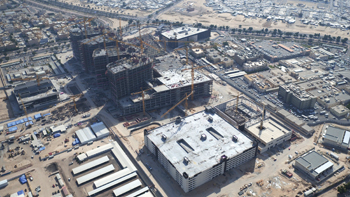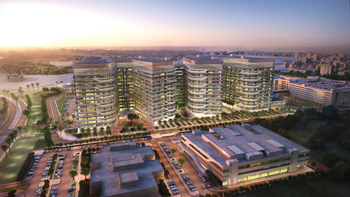Raising the bar
Part of Kuwait’s national plan to offer its people first-class healthcare, the New Jahra Hospital with 1,171 beds is a full secondary care specialties centre.
01 December 2017
One of the largest healthcare projects in the Middle East, the 1,171-bed New Jahra Hospital is currently taking shape on a 440,000-sq-m site at a cost of $1.18 billion. Due for completion in March 2018, the 15-storey complex is part of Kuwait’s national health plan that aims to allocate 22 beds for every 10,000 people by 2030.
The new hospital is being built on land adjacent to the existing Jahra Hospital, one of Kuwait’s six main public hospitals which opened in 1981 in the Jahra Province.
Work on the New Jahra Hospital, which is being developed by the Amiri Diwan, commenced in March 2015, and is about 70 per cent complete. Pace is the project consultant and Kharafi Construction (MAK) is the contractor.
Unlike typical hospitals, the main components of the new complex are not all clustered in one zone. Spaces for diagnosis and treatment clinics, emergency and outpatient services, operation rooms (ORs), and inpatient beds are well arranged in a form that services the function and circulation of building users, where the main lobby becomes an open walkway that provides easy movement and access, Engineer Tarek Shuaib, CEO of Pace, tells Gulf Construction.
The architectural design concept is based on introducing the external element of nature into the internal environment to contribute to the treatment and healing of the patients, he says. Green areas and interior spaces play an active part in reinforcing this approach.
The New Jahra Hospital will offer 156 beds for female patients, 98 for the neonatal intensive care unit (NICU), 168 paediatric beds and 749 for adults, in addition to three VIP suites. The hospital will feature a fully-equipped dental facility with 115 treatment rooms, a regional health administration building and associated parking structures, a central utility plant, and infrastructure.
The medical facility will have a women’s centre; a trauma centre; 32 operating rooms, including two hybrid operating rooms (ORs), a CT scan operating room and an interventional MRI suite. The outpatient facilities have 22 departments with 135 clinics with state-of-the-art equipment, which include a 10-seat hyperbaric chamber – the only one of its kind in Kuwait. The accident and emergency (A&E) department will have 20 ORs, one MRI, one CT scan and two ultrasound rooms along with 96 observation beds.
Project Overview
The overall medical complex comprises eight separate buildings. The main hospital building will provide all secondary care clinical specialties as well as select tertiary care services, complemented by all clinical and non-clinical support, general administrative departments and services. A helipad is located on the rooftop of the diagnostic and treatment block, right above the emergency department’s trauma section.
The internal spaces are created around a five-storey-high central atrium and include a number of newly developed medical facilities and health services, a diagnosis and treatment wing, as well as outpatient clinics in the western wing. The patient wards occupy 14 storeys in the east wing, along with private patient rooms and a diagnosis and treatment area. It is well serviced with adequate elevators and escalators for patients and for the transfer of cleaning and waste services.
 |
|
Under construction ... the New Jahra Hospital will be one of the largest hospitals in the region. |
Other facilities include:
• The 38,766-sq-m women’s centre with 20 labour and delivery rooms, nine ORs and a laparoscopy unit;
• The 28,000-sq-m multispecialty dental clinic centre with 120 dental chairs and clinical and non-clinical support, general administrative departments and services;
• The 5,200-sq-m regional health administration building; and
• Service buildings including a public car-park with a total built-up area of 105,000 sq m covering a basement, ground, and five upper levels and accommodating 3,000 cars. Staff will be provided 1,660 parking slots in a separate building that will consist of a basement, ground, and five upper levels involving a total built-up area of 61,300 sq m. Each of these parking areas will provide emergency shelter for 300 people in the basement.
The entire site will be served by a central utility plant while two major electrical stations (132/11 kV) will be constructed in coordination with the Ministry of Electricity and Water.
According to Shuaib, the hospital’s facades reflect Pace’s innovative and design proficiency of using sunlight breakers as shading to control Kuwait’s direct harsh sunlight.
“Pace’s approach will manage and balance the exact amount of natural light needed inside the building. This will lead to clear vision to pathways and internal movement circulation to provide a healthy atmosphere, especially when accommodating a large number of visitors in a hospital of this size,” he elaborates.
Shuaib says an additional visual enhancement to the New Jahra Hospital will be the spectacular views overlooking the neighbouring farms from the wards in all four towers, whilst maintaining adequate privacy and tranquility for patient recovery.
The hospital structure is substantially precast with the exteriors mostly comprising glass and reinforced concrete.
Challenges
Speaking of the challenges, Shuaib says there are several considering the New Jahra Hospital’s innovative layout and the short three-year construction schedule.
The first challenge, he says was the project’s scope, which included developing the design to complete construction documents; constructing the buildings and associated site works; testing and commissioning of the MEP (mechanical, electrical and plumbing) and life safety systems; and procuring, installing, and commissioning of the medical equipment.
“A sequence of works had to be developed and enforced that allowed these efforts to proceed concurrently and interface properly. This approach has reduced, at least, two years design time from the normal/traditional design then construct approach,” says Shuaib.
The second challenge was the approximately 11-month procurement and delivery cycle for major materials and MEP equipment from abroad. This required planning in advance including dates for selection, negotiations, approvals, manufacturing and shipping of items including marble from the US, air-handling units from Austria, chillers from the US, boilers from Germany, cooling towers from Italy, pumps from the UK, casework from the US, medical equipment from Europe and North America, and pre-engineered and manufactured modular operating rooms, ICU patient rooms, patient room foot walls, and modular toilets from Germany.
Shuaib says the purchase and delivery of these materials, equipment, and modular rooms were coordinated with the sequence of works to ensure that they were selected and arrived in a timely manner to support the balance of the works.
Another challenge was overcoming the typical construction cycle times for casting all of the concrete structural works in place. To expedite the schedule, the buildings’ structures and portions of the exterior enclosure were built using precast components, which allowed the casting of the structural members for the floors, beams, and exterior elements to occur in a factory (near the site) while the buildings themselves were assembled on the site. Each process occurred concurrently, which reduced the time for completing the structure by approximately seven months as compared to traditional projects.
The fourth challenge, similar to the concrete works, is tackling the typical time required for completing all of the internal spaces in a hospital. To expedite these complicated tasks, the project utilised pre-engineered, manufactured, modular elements. The coordination of these efforts in Europe and North America created new challenges, but this allowed these items to be designed and manufactured while the concrete structure was being assembled.
Shuaib says Pace has ensured the highest standards of construction and environmental safety are constantly maintained throughout the entire project duration by implementing a number of safety measures. The practice inspects the site daily to ensure safe work practices are being applied, and to identify and rectify any safety issues.
In coordination with the contractor, it provides safety training for workers and subcontractors in approximately 10 languages on personal protective equipment, specific operations and duties.
Additionally, it strictly enforces the use of proper personal protective equipment and other associated machine safety equipment such as harnesses and belts, the proper set up of banners, barriers and all signboards.
- Towards ‘New Kuwait’
- New Avenues
- Hub for Jazeera Airways
- Raising the bar
- NFT seals historic deal for Kuwait airport
- Kuwait at a glance



